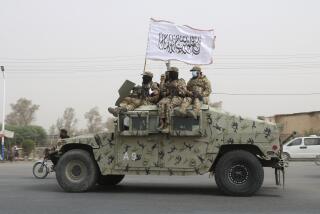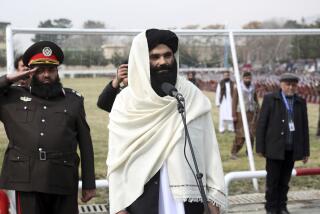A Delicate Balance: Kabul and Provinces
OMAHA — During my last meeting with Ahmed Shah Masoud, two months before his assassination, the popular Northern Alliance commander described his vision for how a post-Taliban Afghanistan should be constructed. First, he said, a centralized military and administrative infrastructure would have to be established. A strong center, he felt, would be crucial in managing the millions of weapons remaining in the hands of regional warlords and bandits, as well as in countering the interference by Pakistan and Iran likely to continue along Afghanistan’s periphery. Masoud also endorsed the convening of a grand assembly, or loya jirga, followed by parliamentary elections two years later (a process later codified in December’s Bonn accord). He suggested that provincial elections should take place only after the country had reached a plateau where stability and reconstruction were well-advanced.
Masoud’s idea that a strong center is essential to Afghanistan’s survival seems obvious. Yet, some in Washington and elsewhere argue that aid should also continue to flow to the warlords operating around Afghanistan’s periphery. A strong centralized government may be impossible, they warn, destined to be brought down by factionalism and tribalism. Better, then, to continue U.S. assistance to local warlords at the same time we offer support to the government of Prime Minister Hamid Karzai. This approach is doomed to backfire.
It also ignores history. Afghanistan’s self-governing structure evolved internally, over time, and while its institutions developed some of the flaws common in the Third World--inefficiency, nepotism and corruption--the regions of Afghanistan nonetheless coalesced as a country.
For 50 years, ending with the 1979 Soviet invasion, Afghanistan’s centralized military and administrative infrastructure functioned effectively. In return for resources flowing to the regions from Kabul, local tribal and clan chiefs provided security in their areas as well as cooperation with the center. The center-province balance was buttressed by the Kabul government’s respect for local tribal and clan influence in Afghanistan’s outlying regions. Regional leaders periodically met each other in Kabul as members of parliament, as participants in loya jirgas and at meetings organized by the central government. In 1964, a loya jirga approved a constitution. In 1965 and 1969, democratic parliamentary elections were held.
Governors were appointed by the central government to administer Afghanistan’s 29 provinces. To dampen centrifugal tendencies, the central government generally appointed governors who were not from the localities they served. The ministries in Kabul assigned personnel to each province, further enhancing central control. These representatives implemented beneficial programs in the regions, to address needs ranging from health and agriculture to finance and public safety. They reported both to their ministries in the capital and to the local provincial governor.
It was to this model of successfully functioning governing institutions that Masoud looked in formulating his ideas for Afghanistan’s post-Taliban reconstruction. And it is to this model that the international community must now look as well, making revival and modernization of Afghanistan’s pre-war governing institutions a strategic priority.
This will require an about-face for the United States. In recent years, we grew used to working with the warlords of outlying areas to help defeat the Taliban: Now we must encourage the central government with our bounty, even if it means cutting off former allies. Most of today’s warlords are the same militarists who proved so destructive and brutal in the chaotic period from 1992 to 1996, when a series of pitched battles for control culminated in the Taliban’s seizure of power.
These warlords have reestablished themselves in their own areas over the past four months. And while many currently express support for the Karzai regime in Kabul, this is likely to change as the interim regime consolidates its strength. Afghan warlords, like Mohammed Farah Aidid in Somalia, seek only to amass personal power and line their pockets. Most, like Gen. Abdul Rashid Dostum, Kandahar Gov. Gul Agha Shirzai and dozens of other warlords in eastern Afghanistan, were previously deep into drug trafficking. Almost all lack even an elementary school education. Their fighters are usually illiterate with no prospect for employment except as hired gunmen. The warlords will happily sell their services to the Americans, the Pakistani military intelligence, Muslim extremists or all three simultaneously. But in the end they have allegiance only to themselves, which is in part why we have had such trouble locating Osama bin Laden and Taliban leaders.
The onus should remain on the Afghan interim regime to rein in the warlords and restore stability in Afghanistan. But this will not be easy. As the recent apparent assassination of the country’s aviation and tourism minister, Adul Rahman, demonstrated, tensions run high, even within the ruling coalition. Afghanistan’s fledgling government cannot restore order alone. The International Security Assistance Force (ISAF) must gradually fan out to key Afghan towns, providing assistance as the interim regime’s administrative and military institutions are reestablished in the regions. The Pentagon should decisively act on President Bush’s stated commitment to help build a modern Afghan army. And the U.S. and its allies should coordinate with the regime to buy up warlords’ tanks, artillery and rocket launchers and then help ensure that outside entities do not, as they have in the past, assist the warlords in restocking their arsenals.
In the short term, it may be politically necessary to appoint warlords as governors in some regions: Many have considerable support and are needed as allies of the central regime rather than enemies. But, as was the rule before the Soviet invasion, a governor should not be allowed to concurrently serve as regional military commander, a position that should report directly to the defense ministry in Kabul rather than to local authorities.
The most efficient way to break up the warlords’ militias may well be to conscript their soldiers, who often don’t have other means of employment, into the new national forces. Before the Soviet invasion, all Afghan youth entered the military for two years at age 22. After basic training, some were sent to regular military units around Kabul or to one of the regional military commands. Thousands were also assigned to either the civilian ministry of public works or the ministry of agriculture, to build roads or to carry out large agricultural projects. Army generals were permanently stationed at these two ministries, working under the ministers to oversee the military construction units.
This kind of service worked well before and could serve as the model for a new, enlarged program. It is cheap. Afghans are familiar with its administration. Most important, young Afghans would not become dependent on warlords for their livelihoods--nor would warlords have as large a supply of young men with whom to build a fighting force. As in the past, Pushtun conscripts in the south could be sent to projects in the north; northern Uzbeks, Tajiks and Hazaras would serve in the south. The program could be a useful tool in accustoming young people once again to the idea of a multiethnic nation.
It would be naive to think that a governmental structure destroyed during 23 years of war can be instantly reconstituted and reformed to meet the needs of today’s Afghanistan. But neither must a new government be created from scratch. Effective government institutions will be essential to Afghanistan’s continued development when foreign aid tapers off. Our task, therefore, is to assist Afghanistan in reviving and modernizing its democratic, administrative and military institutions. To abandon that task before it’s begun in favor of a decentralized array of squabbling warriors would not only ignore Afghanistan’s history, it would negate its future, reopening the door to chaos, war and radical Muslim terrorism in Central Asia.
*
Peter Tomsen was U.S. Special Envoy and Ambassador on Afghanistan from 1989 to 1992. He is currently U.S. Ambassador in Residence, University of Nebraska at Omaha.
More to Read
Sign up for Essential California
The most important California stories and recommendations in your inbox every morning.
You may occasionally receive promotional content from the Los Angeles Times.









